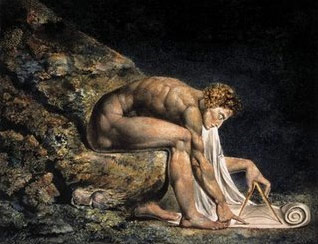
| HOME |
| NERVE |
| REVIEWS |
| ARCHIVE |
| EVENTS |
| LINKS |
| ABOUT US |
| CONTRIBUTORS |
| BACK ISSUES |
| CONTACT US |
 William
Blake: The River of Life
William
Blake: The River of Life
Tate Liverpool
12th December 2008 - 29th March 2009
Reviewed by Adam Ford
It was an extraordinary privilege to get up close and personal with some of William Blake's most celebrated artwork at Tate Liverpool. Unfortunately though, the selection presents a limited view of a man who was a visionary in every possible sense.
Born in 1757, at a time of enormous changes in English society, Blake's output was full of contradictions, but he embraced this, believing that "Without contraries there is no progress". The son of Christian Dissenters - who resented the state's interference in religion and vice versa - his approach to faith was very much an anti-establishment one, and he drew upon traditions dating back to the English Civil War to create often apocalyptic images, reflecting the turmoil that surrounded him throughout his life.
The religious artwork chosen for The River of Life appears - without further explanation - to be quite conventional. There is Blake's interpretation of Dante's Inferno, which comes from the Medieval Catholic idea of Hell. There are also many depictions of events from the Old Testament. One in particular, Satan Exulting over Eve, might seem like a standard Garden of Eden painting. However, Blake's mythology went way beyond God is good and the devil is evil. For him, the church was a restrictive body which damned and divided humanity, and priests were "Dishonest, Designing Knaves who in the hope of a good living adopt the State Religion". On the other hand, Hell and demons were associated with vital, passionate energies like anger and lust. Blake saw the biblical Satan as having set humanity free to be like the rest of creation, so a serpent 'exulting' over a female form was groundbreaking symbolism at the end of the eighteenth century.
Another fascinating subject for Blake was what role religion would play in a world that was starting to be explained by rational, calculating, profit-seeking science. This is given a small airing in the exhibition. He wasn't against technological development - he made great use of it on many occasions - but disliked the direction that many of its backers were pushing it in. Like his fellow Romantics, he believed in the power of imagination and emotions, claiming that even the greatest scientists (like his Isaac Newton, above) were missing out on a world that could not be measured.
Actually, there is no room in The River of Life for Blake the philosopher, whose thinking perhaps reached its most dizzying heights in The Marriage of Heaven and Hell (1793), and especially The Proverbs of Hell, which turned conservative Christianity on its head to create a manifesto for life that still looks gloriously wild and yet far-thinking over two hundred years later. Neither is there space for Blake the poet, whose beautifully illustrated texts still fill many schoolbooks (sadly, my teacher told me The Tyger was about a tiger, and not the spirit of the French Revolution). In fact Blake the radical, anti-slavery campaigner and free love advocate is totally banished from the Liverpool Tate this winter, which is a shame, because Tate London exhibited him in 2000/01.
A display even repeats the fiction that Blake was some kind of jingoistic English nationalist, and imagines him cheering on Prime Minister William Pitt's 1793 attack on France (see The Spiritual Form of Pitt Riding Behemoth). The source of this insulting claim is usually Blake's poem 'And did those feet in Ancient time', a full-blooded incitement to revolution that was turned into the dirge-like patriotic anthem 'Jerusalem' by Christians and reactionaries who can't have spent much time wondering what "arrows of desire" might be. Here, Blake pledges "not to cease from mental fight" or let his "sword sleep in [his] hand", until the "Satanic mills" have been destroyed and a heaven on earth worthy of Jesus the rebel has been created "in England's green and pleasant land".
William Blake was the artistic representative of a layer that was constantly on the margins of society, and yet he artistically engaged with it to the best of his enormous ability. His New Jerusalem is far from being created on earth, but his inspirational ideas echo on.
Comments:
Comment left by Bazz on 19th December, 2008 at 16:25
I totally agree with the reviewer. The feeling of awe from being in the same room as these symbol soaked works of art was tainted by the poor presentation. It was as if it had been cobbled together by a school kid. While some works had relatively fulsome (though misleading) notes, others had nothing, and the placing of the notes was in some cases, inconvenient to say the least. To view the Dante wall, I had to keep returning to the notes at the start of the row to find information on each exhibit. Very poor, Tate Liverpool.